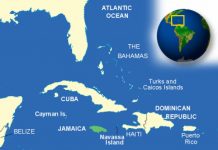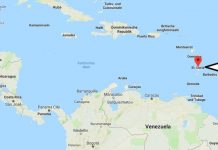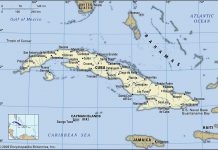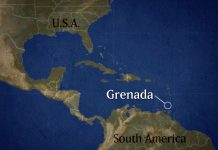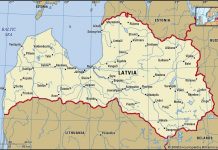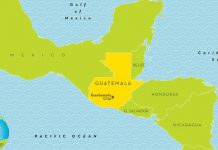Republic of Cyprus
Capital: Nicosia
Area: 9,250 sq km /3,571 sq mi
Population: 734,000
Population density per sq. km/sq. mile: 79/206
Ethnic composition
About 80% of the population is of Greek origin and speak Greek. And about 18% have Turkish roots and consider Turkish as their native language, they mostly live in the northern part of the island within the Turkish Republic, which declared its independence.
Religion
Those living in the south are mostly parishioners of the Greek Orthodox Church (about 444,000), and about 105,000 Muslims live in the north.
History
Originally belonging to Greece, Cyprus was conquered by the Turks in 1571, and then in 1878 by the British Empire and annexed to Pei in 1914. In 1955, a guerrilla war against .the rule of Britain and for unification with Greece. The movement was led by the 11-nation Organization of Cypriot Fighters (POKB), and its political and military leaders were the head of the Greek Orthodox Church in Cyprus, Archbishop Makarios III (1913-1977) and General George Grivas (1898-1974). Makarios and other leaders were expelled from the island in 1956 for their liberation activities .
After three years of persistent negotiations, Makarios was allowed to return to Cyprus, and after the island gained full independence, he was elected president of the new Greek-Turkish state. When signing the agreement on the independence of Great Britain, it was allowed to place its naval bases on the island.
Relations between the Greek and Turkish political leaders deteriorated, and in 1963 they abandoned joint rule, deciding to create their own independent republic. The following year, UN peacekeeping forces were called in to establish order. After a long period of mutual hostility, relations gradually improved, and it became possible to start negotiations again, at which, however, the Turks demanded the establishment of a federal state, and the Greeks — a unitary one. In 1971 General Grivas returned to the island and led a resistance movement against the Makarios government, convinced that it had failed the Greek unification. Three years later, Grivas died, and Makarios tried to get rid of his henchmen. However, he was himself deposed by Greek National Guard officers and Nikos Sampson, who called for unification with Greece. Makarios flew to the UK. At the request of the leader of the Cypriot Turks, who feared extremist Sampson, Turkey sent troops to the island, taking control of the northern region and dividing Cyprus by drawing the “Attila” line, separating V3 territories. Later, in 1974, Sampson resigned, the military regime that had appointed him as president was gone, and Makarios returned. Meanwhile, the Turks formed their own independent government of the Turkish Republic of Northern Cyprus, headed by President Rauf Denktash (born in 1924) in 1977.
In 1977, Makarios died, and his successor was Sniros Kyprianou, who was the head of the House of Representatives. He turned to the international community for help, and in 1980 negotiations were held between the Greek and Turkish communities with the financing of the PLO. Representatives of the Turkish population of Cyprus demanded to return to them about 4% more of the territory under their control and to resettle about 40,000 of the 200,000 refugees who fled to the north of the island, but they did not receive the consent of the Greek side, and negotiations reached an impasse. The Turks demanded equal status for both communities, equal representation in government and the establishment of close ties with Turkey. The Greek side preferred an alternative presidency, strong centralized government and representation in parliament on a proportional basis.
From 1982 to 1985, the Greek government in Athens made a number of attempts to find a compromise, but just like the OOI attempts, they ended in failure. The Turkish Republic of Northern Cyprus was formally proclaimed, but received recognition only from Turkey.
In 1985, a high-level meeting between Denktash and Kyprianu was also unsuccessful, and the proposal of the UN Secretary-General to form a federal government of Cyprus with the Greek president and the Turkish vice-president was not accepted. Meanwhile, both the Presidents, Cipriano and Denktash, were re-elected for a new term.
It would seem that the differences between the two communities will remain unsolvable. However, there was a glimmer of light at the end of the tunnel after Ieopruoca Vasiliu came to power in 1988 . It was easier for him than for everyone else to get down to business, since he was not affiliated with any political party. He immediately proposed the creation of a government of national unification and took a number of steps towards Greek-Turkish reunification. However, despite a series of negotiations with the Turkish Cypriot leader under the supervision of the UN, hopes for reunification were not fulfilled.
In 1993, Glavkos Clerides, a candidate from the DS, won the presidential election. Clerides continued to look for ways to unite parts of the island, and in May 1995, negotiations between the two communities were held. In June 1997, the initiator of the Dayton Peace Treaty, Richard Holbrooke, was appointed UN envoy to Cyprus, but in April 1998 he announced that his mission had not been crowned with success. Meanwhile, President Clerides was re-elected and formed a unification government, which included members of the DS, the Liberal Party, and members of the rival Democratic Party (DP). In November 1998 The European Union has begun negotiations on the accession of Cyprus to its membership.



















